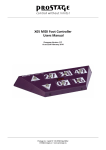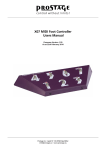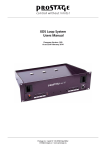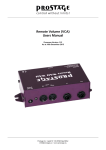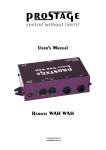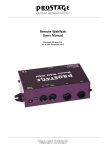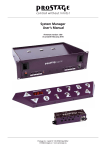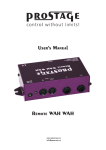Download Switcher Users Manual
Transcript
XTMpro Adaptor XTMpro-R Adaptor | Switcher Users Manual Firmware Version 1.80 As at 22th February 2014 XTMpro XTMpro-R Prostage S.L. • Apdo 57 • ES-07560 Cala Millor [email protected] • www.prostage.eu Table of Contents 1 Introduction 3 1.1 1.2 XTMpro Features The Prostage System 3 3 2 Terminology 4 2.1 2.2 2.3 2.4 2.5 MIDI StageWire Stompbox Mode = Instant Access = On/Off Switches Preset | Program Change Relay 4 4 4 4 4 3 Controls and Connectors 5 3.1 3.2 The Front Panel The Rear Panel 5 6 4 Programming & Operation 7 4.1 4.2 4.3 Creating Presets directly at the XTMpro (XTMpro-R only) Switching the Relays with Instant Access Switches (Stompbox Mode | Direct Switching w/o Presets) Programming with the System Manager Software 7 7 7 5 Firmware Upgrade 7 6 MIDI Implementation Chart 7 7 Warning Instructions and Warranty 8 7.1 7.2 7.3 Warnings and Safety Instructions Warranty / Support Disposal of Old Devices 8 8 8 8 Declaration of Conformity 9 NOTE => This manual uses digital bookmarks. You can show them by clicking on the "flag" icon in the top left of Acrobat Reader. A click on a topic flips directly to that chapter. Page 2 1 Introduction Dear Customer Thank you for purchasing the Prostage XTMpro adaptor | switcher. The XTMpro is the control center and the heart of a Prostage system. It is the interface between StageWire and MIDI. The XTMpro offers an extensive MIDI mapping to control MIDI equipment, as well as a tap function. The version XTMpro-R further provides four relay switching outputs to switch functions of your guitar amplifier (channel switching, reverb, boost, etc.). The XTMpro-R is suitable to control and switch the entire guitar rig from a single MIDI foot controller. With a Prostage foot controller or any other MIDI footswitch sending MIDI Control Changes, you can easily turn on and off the switching outputs of the XTMpro-R (Stompbox Mode | Instant Access). Another approach would be creating unique presets for each sound, accessible via the MIDI foot controller switches. Or you could combine the preset-approach with the Stompbox Mode. 1.1 XTMpro Features •StageWire technology: Connection to the foot controller using a standard microphone cable. •Phantom power for Prostage foot controllers. •Works with all MIDI footswitches. •Extended programmability via System Manager software for PC or Mac. •MIDI Mapper to control connected MIDI gear. •128 programs can be saved in memory. •Tap relay connection. Version XTMpro-R: •Four relay switching outputs. •Easy programmability of the switching outputs via front panel buttons. •LEDs display the switching states. •Responds to Program Change and Control Change messages. 1.2 The Prostage System Prostage stands for professional live-equipment. The XTMpro is plug and play. This means that you can plug it in and use it, without having to configure anything. You can easily store the settings for the switching outputs directly at the unit. Prostage foot controllers are connected to the XTMpro by one standard microphone cable! The StageWire technology developed by Prostage thereby achieves a secure connection between the foot controller(s) and the XTMpro. A standard MIDI foot controller can be connect to [MIDI In] on the rear panel. Prostage’s philosophy is “control without limits”. We want you to be able to setup your system exactly as you want it to work while keeping it as simple to use as possible. Therefore, there are lots of things inside the system you can configure yourself. To setup the additional features of the XTMpro, you need the System Manager software. This is available on our website for free download ( Mac & PC). You will notice that the chapters for connecting the system and the separate users manual for the Prostage System Manager software are very extensive, while the chapter “Programming & Operation” does not even fill a single page. This means: once you have configured the system properly, you will be able control your entire equipment with one single footstep. If you have any questions, or if something does not work as you expect, please do not hesitate to contact us: info@ prostage.eu. Your questions will also help us to improve this users manual. The Prostage team wish you lots of fun with the new XTMpro and big success in your musical career. Lukas Truninger Founder & Developer Page 3 2 Terminology 2.1 MIDI MIDI is Voodoo? This is wrong! Although, MIDI can do much more, what you need as a guitarist, is very simple. This is how MIDI works: A device - such as a foot controller – sends a command to another device - e.g. the XTMpro - using a MIDI cable. The transmitting device - the foot controller - notifies the recipient - the XTMpro what it shall do. That’s all. You can connect your Prostage devices and use the basic functions directly, without having to deal with MIDI. If you want to use the advanced functionality of the system, you can find more detailed information on MIDI in the users manual of the System Manager software. 2.2 StageWire StageWire is a further development of MIDI. The technology has been developed by Prostage specifically for the use on stage. StageWire is a connection where multiple devices communicate with each other (bidirectional) via a standard microphone cable. Using StageWire, you can interconnect up to 14 Prostage foot controllers to control the XTMpro. The foot controllers are joined together in a chain. This means, you simply run a microphone cable from the first foot controller to the second, another cable from the second to the third foot controller, and so on. The foot controller(s) are supplied with power by the XTMpro. 2.3 Stompbox Mode = Instant Access = On/Off Switches Instant Access are “direct-access switches.” These on/off switches work like an analog pedal switch, which is connected directly to the amplifier, for example, to switch between the channels. So at the foot controller, you can define a switch, which is e.g. firmly assigned to a switching output of the XTMpro. This switch, then, simply turns on and off the switching output at the XTMpro. 2.4 Preset | Program Change Presets are saved settings that can be recalled with a switch on the foot controller (= Program Change). A preset contains all settings of the amplifier and effects belonging to a sound (e.g. Clean). You create, for example, the following presets : •Preset 1 (Clean) => Channel 1 of the amplifier & chorus switched on •Preset 2 (Lead) => Channel 2 of the amplifier & delay and booster activated If you press button 1 on the foot controller, the amplifier switches to channel 1 and the chorus is turned on. If you press button 2, the amplifier switches to channel 2. The delay and the booster are turned on. The chorus is turned off simultaneously. So you can switch your complete guitar rig with a single button. You no longer need to perform a tap dance on different switches to adjust your sound. 2.5 Relay The Prostage XTMpro adaptor | switcher uses relays for switching the switching outputs. Relays are remotely controllable switches. Page 4 3 Controls and Connectors 3.1 The Front Panel StageWire™ foot controller store 1 2 3 relais switches 4 StageWire | Foot Controller Prostage foot controllers are connected to the StageWire connector of the XTMpro using one standard microphone cable. The cable can be up to 200 meters long. Also, a connection over an audio multicore is possible. The foot controller is phantom powered by the XTMpro. (=> A standard MIDI foot controller can be connected to the [MIDI In] on the rear panel.) NOTE => StageWire does not work with phase reversed cables (microphones still work like this). Make sure that the cables are soldered properly. IMPORTANT => “Old” Prostage foot controllers without StageWire connection are partly compatible with the XTMpro. Please contact us ([email protected]) before you connect one of these foot controllers to the XTMpro! Power LED The red LED of the XTMpro indicates that the system is operating: Blinking LED Solid LED LED flickers => the XTMpro is working, but no foot controller has been detected at the StageWire port. => The System is working and the communication with the foot controller works properly. => The XTMpro is receiving data on StageWire input. Switching Relay Outputs (XTMpro-R only) The switching relay outputs are used to control foot-switchable features of your guitar amp or any other device. This could be channel switching, boost, reverb, etc. Thus, the XTMpro replaces the classic footswitch of your amp. The channels and functions are switched by a MIDI foot controller instead. To use one or more of these switching relays, connect a relay output using a standard jack guitar cable to the footswitch jack of the amp. If your amp has a two button footswitch with a stereo jack plug, you have to use an insert cable (also known as Y-cable). An insert cable has two mono plugs on one end. These are plugged into two relay outputs of the XTMpro. The other end of the insert cable has one stereo jack plug, which goes to the footswitch jack of the amplifier. If the amplifier has a multipin connector, we may offer a special (custom) cable. Pressing the relay button on the XTMpro controls the same channel or function that your footswitch would do. The four relay switching outputs of the XTMpro-R are completely independent. This means, they have no common ground. So you can switch functions of four different devices too. The pin assignment of the relays is the same as for the “Tap Relais” (see diagram in chapter 3.2). The relays can also be used as toggle-switches. Relay Buttons (XTMpro-R only) These buttons turn the switching outputs (the relays) of the XTMpro on and off. The LED on the left side of each button is lit when the corresponding relay is on. Store Button (XTMpro-R only) By pressing the Store button twice, the configuration of the switching outputs is saved to the current preset number. The current preset number is the one last recalled in the XTMpro. Page 5 3.2 The Rear Panel � tap relais 9-12V . max. 1A in midi out A out B usb Power Connector The XTMpro adaptor is powered by a 9V or 12V, AC (alternating current) or DC (direct current) power supply. The current required depends on how many foot controller and which models are connected. An X10 needs 300mA, X01 and X05 150mA, the X07 100mA. Maximum load of the XTMpro is 1000mA. Tap Relais The [Tap Relais] connection is an isolated switching contact. If your effects device has a connection for a tap footswitch, you can connect it with the [Tap Relais] connection of XTMpro (using a normal jack cable). One switch on the foot controller can then be used to adjust tempo-based parameters of the effect unit such as delay times. This is done by beat-related tap on the switch. Alternatively, the [Tap Relais] can also be used as a programmable switch to alter amp channels. The [Tap Relais] is a toggle switch: Shield=> common terminal Ring => normally closed Tip => normally open MIDI MIDI In => You can connect a standard MIDI footswitch or a sequencer here to send MIDI commands to the XTMpro. MIDI Out => MIDI data received at [MIDI In] or [StageWire] can be directly forwarded through MIDI [Out A], MIDI [Out B] or both (MIDI thru). Further, any MIDI commands processed by the MIDI mapping of the XTMpro can be sent via these outputs. There are lots of possibilities to map, distribute, modify and forward the MIDI data inside the XTMpro. These settings are made using the System Manager software (Please consult the users manual of the System Manager software). USB The USB connection is used for the communication with the System Manager software. Page 6 4 Programming & Operation 4.1 Creating Presets directly at the XTMpro (XTMpro-R only) Inside the XTMpro, you can save 128 presets. The switching relay states (e.g. amp channel switching) can be easily programmed: •First, choose on the foot controller the program number for which you want to save the settings. Thus, the corresponding preset is recalled in the XTMpro. •Enable / disable the relays as you like them to be activated in this preset using the switches on the XTMpro. •Finally, press the store button twice. Thus, the current setting of the four relays will be stored to the current preset number. To indicate that the new preset is stored, the red LED turns off for a brief moment. IMPORTANT => Whenever a switching output is switched, whether by hand or by preset changes, the XTMpro sends the new switching state on the StageWire bus, so that all foot controller (eg X07) display the switches current state. 4.2 Switching the Relays with Instant Access Switches (Stompbox Mode | Direct Switching w/o Presets) The switching relays can also be switched on and off directly with a switch on the foot controller, so as with a simple analog footswitch. At the foot controller, one or more switches have to be assigned to this function (e.g. using the Prostage X07). If you use a “standard“ MIDI foot controller, this is done by using Control Change (CC) messages. Which button on the foot controller switches which relay is set by the System Manager software. 4.3 Programming with the System Manager Software All further programming such as setting of the MIDI channel can be done with the Prostage System Manager software (PC or Mac). The software and its users manual can be downloaded for free on our website: www.prostage.eu = > Support = > Download 5 Firmware Upgrade The firmware is the operating system, the software within the XTMpro. New firmware adds more functionality to the system. You can upgrade the firmware to the latest version yourself. All information about this can be found in the manual of the System Manager software. 6 MIDI Implementation Chart The XTMpro is part of the coherent Prostage system. The XTMpro handles all MIDI data as they are configured by the System Manager software. Therefore you will find the MIDI Implementation Chart in the manual of the System Manager software. Page 7 7 Warning Instructions and Warranty 7.1 Warnings and Safety Instructions For reasons of the product liability, we are obligated to make clear certain safety aspects which must not be ignored under any circumstances. The device must not be stored or operated in damp or wet environment. The XTMpro may only be operated with 9V-12V, ~AC or =DC. The device serves for routing MIDI signals as well as for controlling amplifiers and must be used exclusively for this purpose. The equipment may be opened by qualified technical personnel only. There are no user serviceable parts inside the device. In order to avoid damages, you should be careful when transporting and setting up the device. Please avoid strong variations in temperature. Particularly the change from the cold transport vehicle to the, usually warm, stage can cause condensing humidity, which can cause leaks and thus can evoke defects. Usually, 60 minutes are sufficient to equalize the temperature. For transportation, always carry the devices in a robust packing or rack, especially if you change your place of work frequently. No containers filled with liquid may be placed on the equipment! 7.2 Warranty / Support All Prostage PurpleLine units are covered by a 2-year warranty. Prostage shall not be liable if the damage was caused by inappropriate use or if the units are not connected as described in this users manual. There are no user serviceable parts inside the unit. The detailed terms of the warranty can be downloaded from the Prostage website. If you need technical support, please contact your local dealer or email to [email protected] 7.3 Disposal of Old Devices The PurpleLine products are subject to the European guideline 2002/96/EC. All old electric and electronic devices must be disposed separately from the domestic waste, using the collection points provided by the government. The devices may not be disposed with domestic or skip refuse. Information about collecting points or collection dates, can be asked from the local administration or the local waste management company. Please also carry the packing to an environmentally fair disposal. Cardboard boxes can be transferred with wastepaper collections or to the public collecting stations for recycling. Foils of the shipment are collected by the local waste management company and are forwarded to environmentally fair disposal. Page 8 8 Declaration of Conformity Company: Prostage SL Apdo 57 ES-07560 Cala Millor Type of equipment: PurpleLine System Trademarks: Prostage / StageWire Models: XDS, XLS, XTMpro, X10, X07, X05, X01, XB1 The products meet the requirements of the following standards: EMC: Safety: EN 55103-2 | EN 55103-1:2009 | EN 55103-2:2009 EN 61000-3-2 EN 61000-4-2 | EN 61000-4-3 | EN 61000-4-4 | EN 61000-4-5 | EN 61000-4-3 | EN 61000-4-11 IEC 60065:2001 | EN 60065:2002 / A1:2006 / Cor.:2007 / A11:2008 Year:2011 Cala Millor, 14. Dezember 2011 Lukas Truninger, CEO Information to the user: Class B Statement: This equipment has been tested and found to comply with the limits for a Class B digital device, pursuant to part 15 of the FCC Rules. These limits are designed to provide reasonable protection against harmful interference in a residential installation. This equipment generates, uses and can radiate radio frequency energy and, if not installed and used in accordance with the instructions, may cause harmful interference to radio communications. However, there is no guarantee that interference will not occur in a particular installation. If this equipment does cause harmful interference to radio or television reception, which can be determined by turning the equipment off and on, the user is encouraged to try to correct the interference by one or more of the following measures: - Reorient or relocate the receiving antenna. - Increase the separation between the equipment and receiver. - Connect the equipment into an outlet on a circuit different from that to which the receiver is connected. - Consult the dealer or an experienced radio/TV technician for help. © 2014 Prostage SL Page 9









